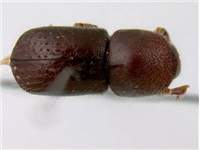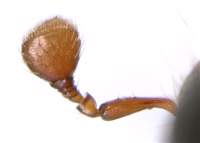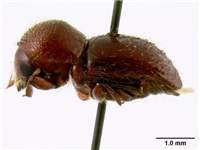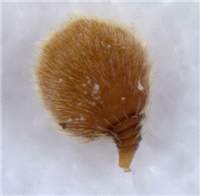Diagnosis
Some of the largest Xyleborini. Body relatively long, pronotum robust, elytral declivity flattened and broadened laterally. Anterior edge of pronotum extended anteriad, bearing a distinct row of serrations. Antennal club often distinctly pubescent, type 4. Very large eyes.
Similar to some large Euwallacea, except margin of segment 1 of antennal club concave, recurved; anterior edge of pronotum produced anteriad, bearing row of serrations; protibiae rounded, with seven or more denticles.
Distribution
SE Asia and Oceania.
Biology
Not known.
Taxonomy
Until recently most species included in Xyleborus.
Detailed description
Eyes shallowly emarginate, upper portion of eyes conspicuously large. Antennal club approximately circular, club type three (with segment 1 straight or convex), or four (segment 1 small, second and third prominent on both sides). Margin of segment 1 of club on anterior face straight (may be slightly concave or convex) or convex; prominent or small; mostly costate, may appear softer on posterior side. Segment 2 corneous on both sides of club, irregularly sinuate, not ring-like. Segment 3 clearly visible on both sides of club. Segment 1 of antennal funicle longer than pedicel, its base stalk-like, funicle 4-segmented, scapus regularly thick. Frons above epistoma rugged, coarsely punctate. Submentum shallowly or deeply impressed, shaped as very narrow triangle. Anterior edge of pronotum with distinct row of serrations, in most species conspicuously produced. Pronotum from lateral view tall (type 2), or rounded and robust (type 5). From dorsal view it is subquadrate (type 3), or quadrate, robust (type 4). Pronotal disc shining or smoothly alutaceous, with small punctures, or densely and evenly punctured, lateral edge of pronotum obliquely costate, usually with a pointed shoulder. Procoxae contiguous, prosternal posterocoxal process conical and slightly inflated. Tuft on pronotal basis associated with mesonotal mycangium absent, setae on elytral bases associated with elytral mycangium absent. Scutellum flat, flush with elytra. Elytral bases straight, with oblique edge. Elytral disc longer than declivity and slightly or distinctly convex, or concave, "saddle-like". Punctures on elytral disc in strial lines. Boundary between elytral disc and declivity indistinct, end of disc rounded and smoothly transitioning into declivity. Lateral profile of elytral declivity mildly convex, especially towards apex, rarely steep, excavated in one species. Dorsal profile of elytral apex rounded, usually broadened laterally. Elytral declivity with few setae or scales, not conspicuously pubescent. Posterolateral declivital costa ending in 7th interstriae, in one species encircling most or all of declivity. Surface of declivity devoid of tubercles, or with uniform granules, or no tubercles on interstria 1 (sutural), and several tubercles on interstriae 2, 3 and beyond, in one rare species tubercles on elevated costa around declivity. Protibiae obliquely triangular, broadest at 2/3 of length, or distinctly triangular, slender on upper part, broad and denticulate on lower part. Posterior side of protibia flat, no granules, only setae. Protibial denticles small, bases of denticles slightly distinctly enlarged, conical, usually between 6 and 8 protibial denticles present. Very large species, 5.2-7 mm. Color uniformly dark brown or black.






